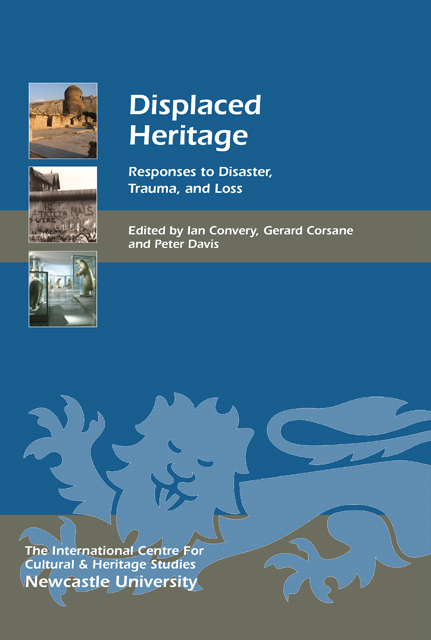Book contents
- Frontmatter
- Contents
- List of Illustrations
- Acknowledgments
- List of Abbreviations
- Preface
- Introduction
- Displaced Heritage: Histories and Tourism
- Displaced Heritage: Trauma, Confinement and Loss
- Displaced Heritage: Lived Realities, Local Experiences
- Displaced Natural Heritage
- Endpiece
- List of Contributors
- Index
- Heritage Matters
1 - Dark Tourism and Dark Heritage: Emergent Themes, Issues and Consequences
Published online by Cambridge University Press: 24 February 2023
- Frontmatter
- Contents
- List of Illustrations
- Acknowledgments
- List of Abbreviations
- Preface
- Introduction
- Displaced Heritage: Histories and Tourism
- Displaced Heritage: Trauma, Confinement and Loss
- Displaced Heritage: Lived Realities, Local Experiences
- Displaced Natural Heritage
- Endpiece
- List of Contributors
- Index
- Heritage Matters
Summary
Introduction
The ways in which societies (re)present death, dying and their dead has long been symbiotic with particular cultural representations of mortality. These representations are often bound up with heritage and tourism, whereby travelling to meet with the dead has long been a feature of the touristic landscape. Examples of early travel to sites of death and the dead can be found in medieval pilgrimages and their reliquary associations, or in Grand Tour visitations to tombs and petrified ruins of the ancient world, or in touristic visits to deceased authors’ homes, haunts and graves during the Romantic period of the 18th and 19th centuries. The historical precedent of how travel (and tourism) provided compelling techniques for imaginatively contacting the dead is well founded (Westover 2012). Thus, despite an increasing academic and media focus on contemporary ‘dark tourism’ – that is, travel to sites associated with death, disaster or the seemingly macabre – the act of travel to such sites is not a new phenomenon (Stone 2011). Nonetheless, the practice of present-day dark tourism has the capacity to expand boundaries of the imagination and to provide the contemporary visitor with potentially life-changing points of shock. Consequently, sites of dark tourism are vernacular spaces that are continuously negotiated, constructed and reconstructed into meaningful places (Sather-Wagstaff 2011). Furthermore, dark tourism can represent inherent political dichotomies of a ‘heritage that hurts’ and, in so doing, offer a socially sanctioned, if not contested, environment in which difficult or displaced heritage is consumed. Given its transitional elements and potential to influence the psychology and perception of individuals, dark tourism as a rite of social passage occurs within constructivist realms of meaning and meaning making. Arguably, dark tourism as part of a broader (dark) heritage context provides a contemporary lens through which the commodification of death may be glimpsed, thus revealing relationships and consequences of the processes involved that mediate between individuals and the societal frameworks in which we reside. The purpose of this chapter, therefore, is to offer an overview of key themes, issues and consequences of how dark tourism can construct and disperse knowledge through touristic consumption of traumascapes that, in turn, can help make contested heritage places salient and meaningful, both individually and collectively. Firstly, however, a review of dark tourism and the tourist experience provides a context for subsequent discussions.
- Type
- Chapter
- Information
- Displaced HeritageResponses to Disaster, Trauma, and Loss, pp. 9 - 18Publisher: Boydell & BrewerPrint publication year: 2014
- 12
- Cited by

